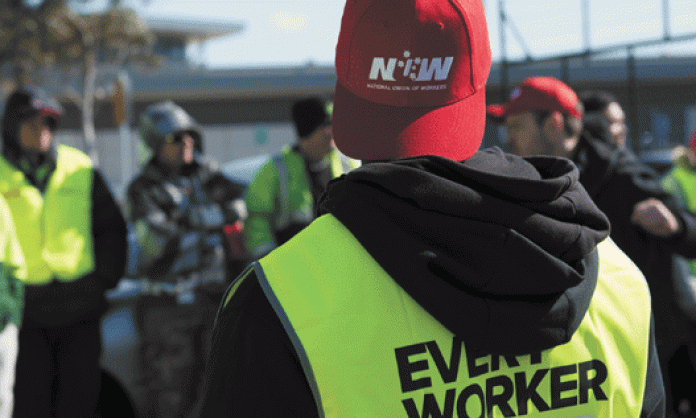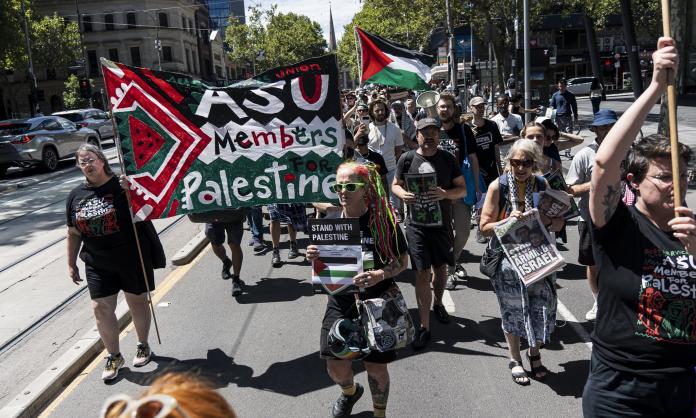For four extraordinary days, workers at Woolworths’ giant Melbourne Liquor Distribution Centre (MLDC) went on a spontaneous, legally unprotected strike and picket. On the morning of 10 August, with no previous history of industrial action, these workers walked off, sparking solidarity actions in other Woolworths sheds in two states. Socialist Alternative industrial organiser Jerome Small spent last week on their picket line. This article should be read alongside Ryan Stanton's "Workers dare to struggle".
----------
“I never thought we’d have the balls to do it”, Fiona (not her real name) chuckles and shakes her head. It’s a Monday morning and, as dawn breaks across the industrial suburb of Laverton in Melbourne’s west, she’s explaining how we come to be standing on a picket line. She’s worked in different roles at Woolworths – in stores and distribution centres – for three decades. She’s never been on strike before.
Usually, by this time of the morning, hundreds of workers in the giant warehouse behind us would be going at full speed, pumping out liquor supplies to Dan Murphy’s and BWS stores throughout Victoria and beyond. This is a key distribution node in the liquor empire that makes Woolworths one of Australia’s most profitable companies – $2.45 billon just last year.
But today, all the activity is on the picket line. Just over a week ago, management announced that all new workers at the shed would be employed by a labour hire company. Fiona tells me how companies like Woolworths love to outsource their workforce. Woolworths’ truck drivers, she says, used to be directly employed by the company. Their pay was something near $40 an hour. Eighteen months ago, Woolworths outsourced the driving to Linfox. The drivers’ hourly rate is now in the low $20s.
This sort of outcome is a real threat for the warehouse workers at the MLDC. In negotiations last year for a new enterprise agreement, management advanced, and then dropped, a claim to introduce agency casuals. So there’s nothing in the agreement either way. There are no clauses on “site rates” or allocation of hours, nothing to stop labour hire workers being paid at a lower rate and used to undercut existing workers.
Labour hire is also a major threat to the workers’ industrial power. Because the agency workers would have a separate employer, they wouldn’t come under the MLDC enterprise agreement. So they couldn’t bargain with their fellow workers, and couldn’t take legally protected industrial action alongside them.
More than that, everyone knows that labour hire is just a shit way to have to work. By increasing job insecurity, it helps management push workers harder, which leads to more injuries – especially when picking heavy boxes of liquor.
Building for a strike
Fiona’s strike inexperience is typical of workers at the shed. While more than 80 percent of workers on site are members of the National Union of Workers, there has never been a strike here. The last two enterprise agreements cut wages or conditions for some groups of workers, and there’s a history of division between different sections of the workforce.
The dispute over labour hire could easily have been swallowed by these divisions.
On the one hand, workers on the floor were outraged at the company lying to them during last year’s enterprise agreement. At one toolbox meeting, where management slipped in an announcement about this major change as an afterthought, emotions boiled over. A number of workers denounced management, with the DC manager in response reportedly yelling at the workers to “fuck off”.
But sentiment alone is never going to change anything. Only organisation and action do that, and the union at MLDC had a patchy record of both.
Not daunted, a group of workers decided to push their union. A series of official union meetings were called for outside the gate. A few short, punchy leaflets appeared around the plant. And hundreds of stickers were spread around for workers to wear – a small but very visible symbol of defiance, which let every pissed off worker know that there were hundreds of others who felt the same way.
“Wherever you were walking, you could see these bright pink stickers”, described one of the workers involved. “Management could see it. We could see it. And they didn’t like it.”
When management cracked down on the sticker wearers, a few dozen workers gathered on the shop floor and went to the management to inquire about it – effectively a small workers’ demonstration. In response, management quickly backed down from the attempted sticker ban. It was a tiny glimmer of how frightened management could be in the face of determined workers. In a workplace with no history of industrial action, this caused a stir.
However, management weren’t just rolling over, and many workers had their doubts. “The union is too piss weak, we may as well give up”, muttered some. “Anyone who goes to an info meeting will be sacked”, went the whispers.
It’s testament to the strength of feeling on the issue – and the push from the more determined – that despite this chorus of fear, and despite having to walk past the spying eyes of top management, more than 100 workers went to the union meetings at the gate on Wednesday, 5 August. Further gate meetings two days later failed to build the numbers, however. So a week after the announcement, the workers still hadn’t managed a serious action. At this rate, it was only a matter of time before their fire turned to resignation.
However, defeatist mutterings were not the only sentiments getting around on the floor. “We should all call in sick”, said some workers. “There should be a mass meeting on Sunday”, said others. And starting off with a few, but quickly becoming a chorus, more workers were saying: “We should just picket the joint out”. The union called a mass meeting on Sunday, 9 August, to discuss the questions.
When the idea of a picket was pitched with conviction, to a crowd of around 100 workers at an official union meeting, there was a strength to it. When the vote was taken, it was unanimous – the workers would picket the whole plant out the next morning.
The picket begins
One hundred workers is a good number for a Sunday union meeting, but the shed has a workforce of more than 500. To picket an entire workplace from a minority position seemed a pretty audacious move.
It felt like an even bigger call just after 4am on a Monday morning, in a dark and a misty winter drizzle, when the first half dozen picketers gathered.
Within a few minutes, numbers built to a dozen – enough to spread out over both car park entrances. A couple of cars conveniently stalled across the entrances. Workers would now have to park outside and walk in, meaning they would have to engage with the steadily growing numbers on the line. A tiny trickle of managers and some workers went through, but the overwhelming majority stopped with their mates on the picket. Within an hour or two, hundreds of workers were picketing. For the first time in its history, MLDC was strikebound.
One worker tells Red Flag that going on strike is “a tick off my bucket list. I’d never done a strike before. For my age, I’m over 50 and it’s been an experience. We have brought every single member, whether they are part of the union or not, we have all stood together from all different departments. Unbelievable solidarity”.
The solidarity has quite an electric effect. Most of us spend the best part of our lives working for someone else. Turn up at this time, do this task, work at this pace, don’t talk back, keep your head down, hope for the best. You’re powerless.
A strike changes this at a stroke. When, all of a sudden, for the first time in a lifetime, hundreds of workers throw that routine out the window, the whole rule book changes. The atmosphere is the opposite of the dull workaday compulsion of economic facts and management control. Workers who have never met are thrown together in conversations ranging over history, union politics, daily life.
Somewhere along the way, negotiations start. The demands, adopted by the first mass meeting on the picket, are clear. No labour hire and no repercussions for strikers. A demand for the DC manager to come and negotiate in front of everyone is briefly entertained, but instead an ad hoc committee of delegates, workers and the union organiser go in to talk.
After some time, they come and report to a picket line meeting. On demand one, “no labour hire”, it’s relayed that, perhaps, the company might shift the timing back a couple of weeks.
On demand two, “no repercussions”, management say that all workers will be allowed back into the plant. But strikers will be placed on a “first and final warning”. Under the company’s system of warnings and file notes, this would mean that, anytime over the next year, any minor or imagined stuff-up could result in instant dismissal. There are no guarantees that some workers won’t be sacked immediately.
There’s a brief, slightly stunned, silence. Then one worker speaks up, and then another – there’s no way anyone is going back on those terms. Whatever discussions might have happened in the negotiating room, away from the wood smoke and camaraderie of the picket line, everyone on the line seems clear. There’s a chorus: “Look, it’s not difficult – no labour hire, no repercussions”.
The determination of the workers is bolstered by the obvious effect of their strike. Monday is a big delivery day, as stores replenish after the weekend. Even on this first afternoon, holes are starting to appear on the shelves at Dan Murphy’s and BWS.
The next day, the numbers are still up and things are getting a little more organised. A small team of workers chats casually to the truck drivers. It seems the truckies are being told by their bosses that, if they can’t deliver their load, to return it to their depot. Management, caught by surprise by the snap nature of the strike, have no plan B.
The spirit of defiance grows. The Fair Work Commission issues an order banning the strike. “Great”, says one worker as a management rep puts the notice in his hand, “we need more kindling for the fire”. Dozens of the notices go up in flames.
Car loads of supporters, including unionists from other sites, family members, students and many members of Socialist Alternative and other groups, come out to the picket. Students and some workers duck off to stores to leaflet shoppers and cause a fuss.
Negotiations resume on Tuesday evening, and new problems arise. Tired already, all of the union reps are bundled into the negotiating room. For around seven hours, the delegates undergo a version of sleep deprivation. The company wants them in that room, which deprives the picket line of important leadership, but doesn’t seem to be offering anything real.
On Wednesday evening, after hours of more negotiations, frustration boils over. A meeting on the picket line debates the issue and votes to withdraw from negotiations.
It seems a tactical mistake. On the one hand, everyone knows that the gaps on the shelves are getting bigger, and that progress in the negotiating room – if there is any at all – is painfully slow. On the other hand, I can’t see the logic of shutting off the talks entirely – especially if they can be conducted by a small group, reporting back to the workers, with the majority of delegates doing what they do best – leading the picket.
The union office calls a mass meeting at 9am on Thursday. A potential application for an injunction is talked up by NUW officials into seeming a near certainty of massive fines, individuals losing houses and maybe even jail. The fact that fines issued against individuals are a rarity, that in those few cases individuals have been helped out by the trade union movement and that unionists are more likely to be struck by lightning than end up jailed in this country – is all glossed over.
If the aim is to change the dynamics enough to push a vote through to restart the negotiations, the meeting is a success. A vote to that effect gets up, and NUW officials and delegates go back in. But the collateral damage on the workers’ morale is immense.
This is a serious matter. Given the lack of preparation for this strike, and the absence of militant experience in the workforce, a strike of this nature relies on spirit, hope and forward momentum. The legal threats have broken the first two and stalled the third. From a vibrant, defiant group, in need of some extra organisation, the picket dissolves into a collection of worried individuals.
A visit by members of the Maritime Union of Australia buoys people a little. And by now, the links with other sheds, made through the union, are starting to pay off. A couple of workers from MLDC have gone up to the Barnawartha shed, also operated by Woolworths, which is handling a bunch of the work displaced from MLDC. A small but enthusiastic meeting on the gate resolves to support the MLDC strike in any way they can.
At Hume, the main general supermarket DC for Woolworths in Victoria, the afternoon shifts stop work for four hours – they have their own local issues, but also want to show support for the workers at MLDC. A meeting at Woolworths’ Sydney Liquor DC votes support for the MLDC workers.
But by now, the negotiations have reached a point where NUW national secretary Tim Kennedy is prepared to put a resolution to the workers. From the accounts I hear afterwards, it’s a bitter meeting. The negotiated deal is voted up two to one.
Labour hire is allowed into the shed, contrary to the strikers’ first demand: a new, shit category of employment is introduced. More workers with fewer rights is hardly a win. However, the draft agreement falls far short of the company’s original aims. Labour hire employees are to be paid the same as everyone else. Their use is limited to about half the year. The choice of company must be approved by the union. These controls don’t do away with the objections to labour hire – over health and safety, job insecurity and work intensity – but they limit the company’s ability to use labour hire to gut union strength at MLDC, and to undercut wages and conditions.
On discipline, the outcome is closer to the workers’ original demand – no repercussions. No striking worker gets a note or warning on their existing disciplinary file. Every worker gets a new file opened called “unprotected industrial action”, and gets one warning on it, to be erased after six months. More serious consequences might result for three workers, over alleged specific acts during the picket. There are assurances that this process does not target workers simply for being active in the dispute. On this and a couple of other clauses, it’s difficult to work out what will happen from what’s written. Very often, it’s strength on the ground – at least as much as the wording of clauses – that determines how a deal plays out.
One third of the workers vote against the proposal. For many of them, a more decisive victory seems like a real possibility. With the weekend fast approaching, and core products like VB and Coopers in critically short supply, the pressure on the company is only increasing. And the possibility of solidarity from other parts of the supply chain has Woolworths worried it won’t be able to fill the gaps.
But after four days on strike, the workers don’t go back empty-handed. They have forced one of the biggest companies in the country to give up its main goals – union busting and wage cutting – in introducing agency casuals. They have come through it with their organisation stronger than ever before and, for the first time, actually tested in battle.
The biggest win, as worker after worker says, is the picket line itself and the strength it has generated. Transferring this strength from the picket line onto the shop floor is no easy job. The picket line might be the workers’ terrain, but management still rules the floor.
But workers at MLDC have shown management – and themselves – that they have the guts to take action. And they’ve shown every worker that if you’re prepared to rip up the rule book when the occasion demands, you can stop even the most powerful companies in their tracks.











